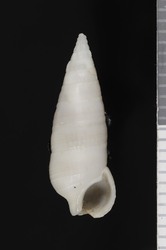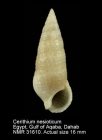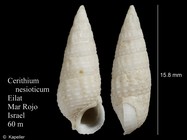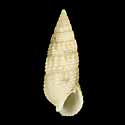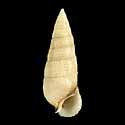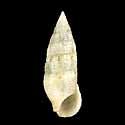WoRMS taxon details
Cerithium nesioticum Pilsbry & Vanatta, 1906
139061 (urn:lsid:marinespecies.org:taxname:139061)
accepted
Species
Cerithium (Liocerithium) lacteum Kiener, 1841 · unaccepted (synonym)
Cerithium (Liocerithium) nesioticum Pilsbry & Vanatta, 1906 · alternative representation (superseded combination)
Cerithium (Semivertagus) lacteum Kiener, 1841 · unaccepted (synonym)
Cerithium (Semivertagus) nesioticum Pilsbry & Vanatta, 1906 · alternative representation (superseded combination)
Cerithium collacteum Iredale, 1929 · unaccepted (junior subjective synonym)
Cerithium lacteum Kiener, 1841 · unaccepted (invalid: junior homonym of...)
invalid: junior homonym of Cerithium lacteum Philippi, 1836; C. pusillum Jay, 1850, C. nesioticum, and C. collacteum are replacement names
Cerithium papillosum G. B. Sowerby II, 1855 · unaccepted (invalid: junior homonym of...)
invalid: junior homonym of Cerithium papillosum Eudes-Deslongchamps, 1842
Cerithium pusillum Jay, 1850 · unaccepted (invalid: junior homonym of...)
invalid: junior homonym of Cerithium pusillum Gould, 1849; C. nesioticum is a replacement name
Cerithium spiculum Hedley, 1899 · unaccepted (invalid: junior homonym of...)
invalid: junior homonym of Cerithium spiculum Eudes-Deslongchamps, 1842
Cerithium voyi Pilsbry & Vanatta, 1906 · unaccepted > junior subjective synonym
Lampania lactea (Kiener, 1841) · unaccepted (synonym)
marine, brackish, fresh, terrestrial
Pilsbry, H. A. & Vanatta, E. G. (1906). On some Pacific Cerithiidae. <em>Proceedings of the Academy of Natural Sciences, Philadelphia.</em> 57: 787-789., available online at https://biodiversitylibrary.org/page/6332227
page(s): 788, textfig. 4 [details]
page(s): 788, textfig. 4 [details]
Distribution Cerithium nesioticum has one of the widest geographic ranges of any cerithiid species. It occurs from the Red Sea south to...
Distribution Cerithium nesioticum has one of the widest geographic ranges of any cerithiid species. It occurs from the Red Sea south to South Africa, throughout the Indian Ocean to SE Asia, Western Australia, and the Indonesian Archipelago. In the Pacific, it is found from Japan south to Norfolk Id, and throughout Melanesia, Micronesia, and Polynesia, as far north as the Hawaiian Islands and east to the Pitcairn Islands. It has also invaded the eastern Mediterranean. [details]
MolluscaBase eds. (2024). MolluscaBase. Cerithium nesioticum Pilsbry & Vanatta, 1906. Accessed through: World Register of Marine Species at: https://www.marinespecies.org/aphia.php?p=taxdetails&id=139061 on 2024-04-19
![]() The webpage text is licensed under a Creative Commons Attribution 4.0 License
The webpage text is licensed under a Creative Commons Attribution 4.0 License
original description
Pilsbry, H. A. & Vanatta, E. G. (1906). On some Pacific Cerithiidae. <em>Proceedings of the Academy of Natural Sciences, Philadelphia.</em> 57: 787-789., available online at https://biodiversitylibrary.org/page/6332227
page(s): 788, textfig. 4 [details]
original description (of Cerithium lacteum Kiener, 1841) Kiener, L. C. (1839-1842). Kiener L.C. 1839-1842. Spécies général et iconographie des coquilles vivantes. Vol. 5. Famille des Canalifères. Première partie. Genres Cérite (<i>Cerithium</i>), Adanson pp. 1-104, pl. 1-32 [pp. 1-32 (1841), 33-104 (1842); pl. 1-32 (1841)]; Pleurotome (<i>Pleurotoma</i>), Lamarck, pp. 1-84, pl. 1-27 [pp. 1-16 (1839), 17-84 (1840), pl. 1-27 (1839)]; Fuseau (<i>Fusus</i>), Lamarck, pp. 1-62, pl. 1-30, 17bis [pp. 1-62 (1840); pl. 2-7, 12, 15-17, 17bis, 22-23, 25 (1839); pl. 1, 8-11, 13-14, 18-21, 24, 26-30: (1840)]. Paris, Rousseau & J.B. Baillière., available online at http://www.biodiversitylibrary.org/item/19762
page(s): pl. 7 figs 3-3a; 58 [1842] [details]
original description (of Cerithium collacteum Iredale, 1929) Iredale, T. (1929). Queensland molluscan notes, No. 1. <em>Memoirs of the Queensland Museum.</em> 9(3): 261-297, pls 30-31 [29 June 1929]., available online at https://www.biodiversitylibrary.org/page/52430219
page(s): 278 [details]
original description (of Cerithium papillosum G. B. Sowerby II, 1855) Sowerby, G. B. II. (1855). Monograph of the genus <i>Cerithium</i>, Adanson. In G. B. Sowerby II (ed.), <i>Thesaurus conchyliorum, or monographs of genera of shells</i>. Vol. 2 (16): 847–899, pl. 176–186. London, privately published. , available online at http://biodiversitylibrary.org/page/11076091
page(s): 876, pl. 184 fig. 215 [details]
original description (of Cerithium pusillum Jay, 1850) Jay J.C. (1850). <i>A catalogue of the shells, arranged according to the Lamarckian system, with their authorities, synonymes, and references to works where figured or described, contained in the collection of John C. Jay</i>. Ed. 4. New York. 459 pp. , available online at https://biodiversitylibrary.org/page/13133875
page(s): 316 [details]
original description (of Cerithium spiculum Hedley, 1899) Hedley, C. (1899). The Mollusca of Funafuti. Part I - Gasteropoda. <em>Memoirs of the Australian Museum.</em> 3(7): 395-488, pl. 27., available online at http://biodiversitylibrary.org/page/33592636
page(s): 433, fig. 21 [details]
original description (of Cerithium voyi Pilsbry & Vanatta, 1906) Pilsbry, H. A. & Vanatta, E. G. (1906). On some Pacific Cerithiidae. <em>Proceedings of the Academy of Natural Sciences, Philadelphia.</em> 57: 787-789., available online at https://biodiversitylibrary.org/page/6332227
page(s): 787-788, text-fig. 3 [details]
context source (Introduced species) Katsanevakis, S.; Bogucarskis, K.; Gatto, F.; Vandekerkhove, J.; Deriu, I.; Cardoso A.S. (2012). Building the European Alien Species Information Network (EASIN): a novel approach for the exploration of distributed alien species data. <em>BioInvasions Records.</em> 1: 235-245., available online at http://easin.jrc.ec.europa.eu [details] Available for editors [request]
[request]
basis of record Houbrick, R. S. (1992). Monograph of the genus <i>Cerithium</i> Bruguière in the Indo-Pacific (Cerithiidae: Prosobranchia). <em>Smithsonian Contributions to Zoology.</em> 510: 1-211., available online at https://repository.si.edu/handle/10088/5554
page(s): 121, figs 86-88 [details] Available for editors [request]
[request]
additional source Zenetos, A.; Çinar, M.E.; Pancucci-Papadopoulou, M.A.; Harmelin, J.-G.; Furnari, G.; Andaloro, F.; Bellou, N.; Streftaris, N.; Zibrowius, H. (2005). Annotated list of marine alien species in the Mediterranean with records of the worst invasive species. <em>Mediterranean Marine Science.</em> 6 (2): 63-118., available online at https://www.researchgate.net/publication/273213810_Annotated_list_of_marine_alien_species_in_the_Mediterranean_with_records_of_the_worst_invasive_species [details] Available for editors [request]
[request]
additional source Spencer, H.G., Marshall, B.A. & Willan, R.C. (2009). Checklist of New Zealand living Mollusca. Pp 196-219. <em>in: Gordon, D.P. (ed.) New Zealand inventory of biodiversity. Volume one. Kingdom Animalia: Radiata, Lophotrochozoa, Deuterostomia.</em> Canterbury University Press, Christchurch. [details]
additional source Steyn, D.G. & Lussi, M. (1998) Marine Shells of South Africa. An Illustrated Collector's Guide to Beached Shells. Ekogilde Publishers, Hartebeespoort, South Africa, ii + 264 pp.
page(s): 38 [details]
additional source Zenetos, A.; Gofas, S.; Verlaque, M.; Cinar, M.; Garcia Raso, J.; Bianchi, C.; Morri, C.; Azzurro, E.; Bilecenoglu, M.; Froglia, C.; Siokou, I.; Violanti, D.; Sfriso, A.; San Martin, G.; Giangrande, A.; Katagan, T.; Ballesteros, E.; Ramos-Espla, A.; Mastrototaro, F.; Ocana, O.; Zingone, A.; Gambi, M.; Streftaris, N. (2010). Alien species in the Mediterranean Sea by 2010. A contribution to the application of European Union's Marine Strategy Framework Directive (MSFD). Part I. Spatial distribution. <em>Mediterranean Marine Science.</em> 11(2): 381-493., available online at https://doi.org/10.12681/mms.87 [details]
additional source Galil, B. (2007). Seeing Red: Alien species along the Mediterranean coast of Israel. <em>Aquatic Invasions.</em> 2(4): 281-312., available online at https://doi.org/10.3391/ai.2007.2.4.2 [details]
additional source Hasegawa K. (2017). Family Cerithiidae. Pp. 788-793, in: T. Okutani (ed.), <i>Marine Mollusks in Japan</i>, ed. 2. 2 vols. Tokai University Press. 1375 pp. [details]
additional source Streftaris, N., A. Zenetos & E. Papathanassiou. (2005). Globalisation in marine ecosystems: the story of non-indigenous marine species across European seas. <em>Oceanogry and Marine Biology: an Annual Review.</em> 43: 419-453. (look up in IMIS) [details] Available for editors [request]
[request]
page(s): 788, textfig. 4 [details]
original description (of Cerithium lacteum Kiener, 1841) Kiener, L. C. (1839-1842). Kiener L.C. 1839-1842. Spécies général et iconographie des coquilles vivantes. Vol. 5. Famille des Canalifères. Première partie. Genres Cérite (<i>Cerithium</i>), Adanson pp. 1-104, pl. 1-32 [pp. 1-32 (1841), 33-104 (1842); pl. 1-32 (1841)]; Pleurotome (<i>Pleurotoma</i>), Lamarck, pp. 1-84, pl. 1-27 [pp. 1-16 (1839), 17-84 (1840), pl. 1-27 (1839)]; Fuseau (<i>Fusus</i>), Lamarck, pp. 1-62, pl. 1-30, 17bis [pp. 1-62 (1840); pl. 2-7, 12, 15-17, 17bis, 22-23, 25 (1839); pl. 1, 8-11, 13-14, 18-21, 24, 26-30: (1840)]. Paris, Rousseau & J.B. Baillière., available online at http://www.biodiversitylibrary.org/item/19762
page(s): pl. 7 figs 3-3a; 58 [1842] [details]
original description (of Cerithium collacteum Iredale, 1929) Iredale, T. (1929). Queensland molluscan notes, No. 1. <em>Memoirs of the Queensland Museum.</em> 9(3): 261-297, pls 30-31 [29 June 1929]., available online at https://www.biodiversitylibrary.org/page/52430219
page(s): 278 [details]
original description (of Cerithium papillosum G. B. Sowerby II, 1855) Sowerby, G. B. II. (1855). Monograph of the genus <i>Cerithium</i>, Adanson. In G. B. Sowerby II (ed.), <i>Thesaurus conchyliorum, or monographs of genera of shells</i>. Vol. 2 (16): 847–899, pl. 176–186. London, privately published. , available online at http://biodiversitylibrary.org/page/11076091
page(s): 876, pl. 184 fig. 215 [details]
original description (of Cerithium pusillum Jay, 1850) Jay J.C. (1850). <i>A catalogue of the shells, arranged according to the Lamarckian system, with their authorities, synonymes, and references to works where figured or described, contained in the collection of John C. Jay</i>. Ed. 4. New York. 459 pp. , available online at https://biodiversitylibrary.org/page/13133875
page(s): 316 [details]
original description (of Cerithium spiculum Hedley, 1899) Hedley, C. (1899). The Mollusca of Funafuti. Part I - Gasteropoda. <em>Memoirs of the Australian Museum.</em> 3(7): 395-488, pl. 27., available online at http://biodiversitylibrary.org/page/33592636
page(s): 433, fig. 21 [details]
original description (of Cerithium voyi Pilsbry & Vanatta, 1906) Pilsbry, H. A. & Vanatta, E. G. (1906). On some Pacific Cerithiidae. <em>Proceedings of the Academy of Natural Sciences, Philadelphia.</em> 57: 787-789., available online at https://biodiversitylibrary.org/page/6332227
page(s): 787-788, text-fig. 3 [details]
context source (Introduced species) Katsanevakis, S.; Bogucarskis, K.; Gatto, F.; Vandekerkhove, J.; Deriu, I.; Cardoso A.S. (2012). Building the European Alien Species Information Network (EASIN): a novel approach for the exploration of distributed alien species data. <em>BioInvasions Records.</em> 1: 235-245., available online at http://easin.jrc.ec.europa.eu [details] Available for editors
basis of record Houbrick, R. S. (1992). Monograph of the genus <i>Cerithium</i> Bruguière in the Indo-Pacific (Cerithiidae: Prosobranchia). <em>Smithsonian Contributions to Zoology.</em> 510: 1-211., available online at https://repository.si.edu/handle/10088/5554
page(s): 121, figs 86-88 [details] Available for editors
additional source Zenetos, A.; Çinar, M.E.; Pancucci-Papadopoulou, M.A.; Harmelin, J.-G.; Furnari, G.; Andaloro, F.; Bellou, N.; Streftaris, N.; Zibrowius, H. (2005). Annotated list of marine alien species in the Mediterranean with records of the worst invasive species. <em>Mediterranean Marine Science.</em> 6 (2): 63-118., available online at https://www.researchgate.net/publication/273213810_Annotated_list_of_marine_alien_species_in_the_Mediterranean_with_records_of_the_worst_invasive_species [details] Available for editors
additional source Spencer, H.G., Marshall, B.A. & Willan, R.C. (2009). Checklist of New Zealand living Mollusca. Pp 196-219. <em>in: Gordon, D.P. (ed.) New Zealand inventory of biodiversity. Volume one. Kingdom Animalia: Radiata, Lophotrochozoa, Deuterostomia.</em> Canterbury University Press, Christchurch. [details]
additional source Steyn, D.G. & Lussi, M. (1998) Marine Shells of South Africa. An Illustrated Collector's Guide to Beached Shells. Ekogilde Publishers, Hartebeespoort, South Africa, ii + 264 pp.
page(s): 38 [details]
additional source Zenetos, A.; Gofas, S.; Verlaque, M.; Cinar, M.; Garcia Raso, J.; Bianchi, C.; Morri, C.; Azzurro, E.; Bilecenoglu, M.; Froglia, C.; Siokou, I.; Violanti, D.; Sfriso, A.; San Martin, G.; Giangrande, A.; Katagan, T.; Ballesteros, E.; Ramos-Espla, A.; Mastrototaro, F.; Ocana, O.; Zingone, A.; Gambi, M.; Streftaris, N. (2010). Alien species in the Mediterranean Sea by 2010. A contribution to the application of European Union's Marine Strategy Framework Directive (MSFD). Part I. Spatial distribution. <em>Mediterranean Marine Science.</em> 11(2): 381-493., available online at https://doi.org/10.12681/mms.87 [details]
additional source Galil, B. (2007). Seeing Red: Alien species along the Mediterranean coast of Israel. <em>Aquatic Invasions.</em> 2(4): 281-312., available online at https://doi.org/10.3391/ai.2007.2.4.2 [details]
additional source Hasegawa K. (2017). Family Cerithiidae. Pp. 788-793, in: T. Okutani (ed.), <i>Marine Mollusks in Japan</i>, ed. 2. 2 vols. Tokai University Press. 1375 pp. [details]
additional source Streftaris, N., A. Zenetos & E. Papathanassiou. (2005). Globalisation in marine ecosystems: the story of non-indigenous marine species across European seas. <em>Oceanogry and Marine Biology: an Annual Review.</em> 43: 419-453. (look up in IMIS) [details] Available for editors
 Present
Present  Present in aphia/obis/gbif/idigbio
Present in aphia/obis/gbif/idigbio  Inaccurate
Inaccurate  Introduced: alien
Introduced: alien  Containing type locality
Containing type locality
From editor or global species database
Distribution Cerithium nesioticum has one of the widest geographic ranges of any cerithiid species. It occurs from the Red Sea south to South Africa, throughout the Indian Ocean to SE Asia, Western Australia, and the Indonesian Archipelago. In the Pacific, it is found from Japan south to Norfolk Id, and throughout Melanesia, Micronesia, and Polynesia, as far north as the Hawaiian Islands and east to the Pitcairn Islands. It has also invaded the eastern Mediterranean. [details]From regional or thematic species database
Introduced species vector dispersal in Israeli part of the Mediterranean Sea - Eastern Basin (Marine Region) : Canals: natural range expansion through man-made canals [details]
| Language | Name | |
|---|---|---|
| Japanese | クリムシカニモリ | [details] |
To ANSP Malacology Collection (syntype of Cerithium voyi. Pilsbry & Vanatta, 1906. Proceedings of the Academy of Natural Sciences of Philadelphia 57: 787-788, text-fig. 3 - catalog no. 58192) (from synonym Cerithium voyi Pilsbry & Vanatta, 1906)
To ANSP Malacology Collection (syntypes of Cerithium nesioticum. Pilsbry & Vanatta, 1906. Proceedings of the Academy of Natural Sciences of Philadelphia 57: 788-789, text-fig. 4 - catalog no. 58193)
To Barcode of Life (23 barcodes)
To Biodiversity Heritage Library (52 publications) (from synonym Cerithium lacteum Kiener, 1841)
To Biodiversity Heritage Library (8 publications)
To Biodiversity Heritage Library (8 publications) (from synonym Cerithium spiculum Hedley, 1899)
To Biological Information System for Marine Life (BISMaL)
To Conchology (Cerithium nesioticum)
To Conchology (Cerithium nesioticum)
To Conchology (Cerithium nesioticum)
To GenBank (3 nucleotides; 3 proteins)
To PESI (from synonym Cerithium collacteum Iredale, 1929)
To PESI (from synonym Cerithium lacteum Kiener, 1841)
To PESI (from synonym Cerithium papillosum G. B. Sowerby II, 1855)
To PESI (from synonym Cerithium pusillum Jay, 1850)
To PESI
To PESI (from synonym Cerithium spiculum Hedley, 1899)
To PESI (from synonym Cerithium voyi Pilsbry & Vanatta, 1906)
To USNM Invertebrate Zoology Mollusca Collection
To USNM Invertebrate Zoology Mollusca Collection
To USNM Invertebrate Zoology Mollusca Collection (from synonym Cerithium spiculum Hedley, 1899)
To ANSP Malacology Collection (syntypes of Cerithium nesioticum. Pilsbry & Vanatta, 1906. Proceedings of the Academy of Natural Sciences of Philadelphia 57: 788-789, text-fig. 4 - catalog no. 58193)
To Barcode of Life (23 barcodes)
To Biodiversity Heritage Library (52 publications) (from synonym Cerithium lacteum Kiener, 1841)
To Biodiversity Heritage Library (8 publications)
To Biodiversity Heritage Library (8 publications) (from synonym Cerithium spiculum Hedley, 1899)
To Biological Information System for Marine Life (BISMaL)
To Conchology (Cerithium nesioticum)
To Conchology (Cerithium nesioticum)
To Conchology (Cerithium nesioticum)
To GenBank (3 nucleotides; 3 proteins)
To PESI (from synonym Cerithium collacteum Iredale, 1929)
To PESI (from synonym Cerithium lacteum Kiener, 1841)
To PESI (from synonym Cerithium papillosum G. B. Sowerby II, 1855)
To PESI (from synonym Cerithium pusillum Jay, 1850)
To PESI
To PESI (from synonym Cerithium spiculum Hedley, 1899)
To PESI (from synonym Cerithium voyi Pilsbry & Vanatta, 1906)
To USNM Invertebrate Zoology Mollusca Collection
To USNM Invertebrate Zoology Mollusca Collection
To USNM Invertebrate Zoology Mollusca Collection (from synonym Cerithium spiculum Hedley, 1899)
